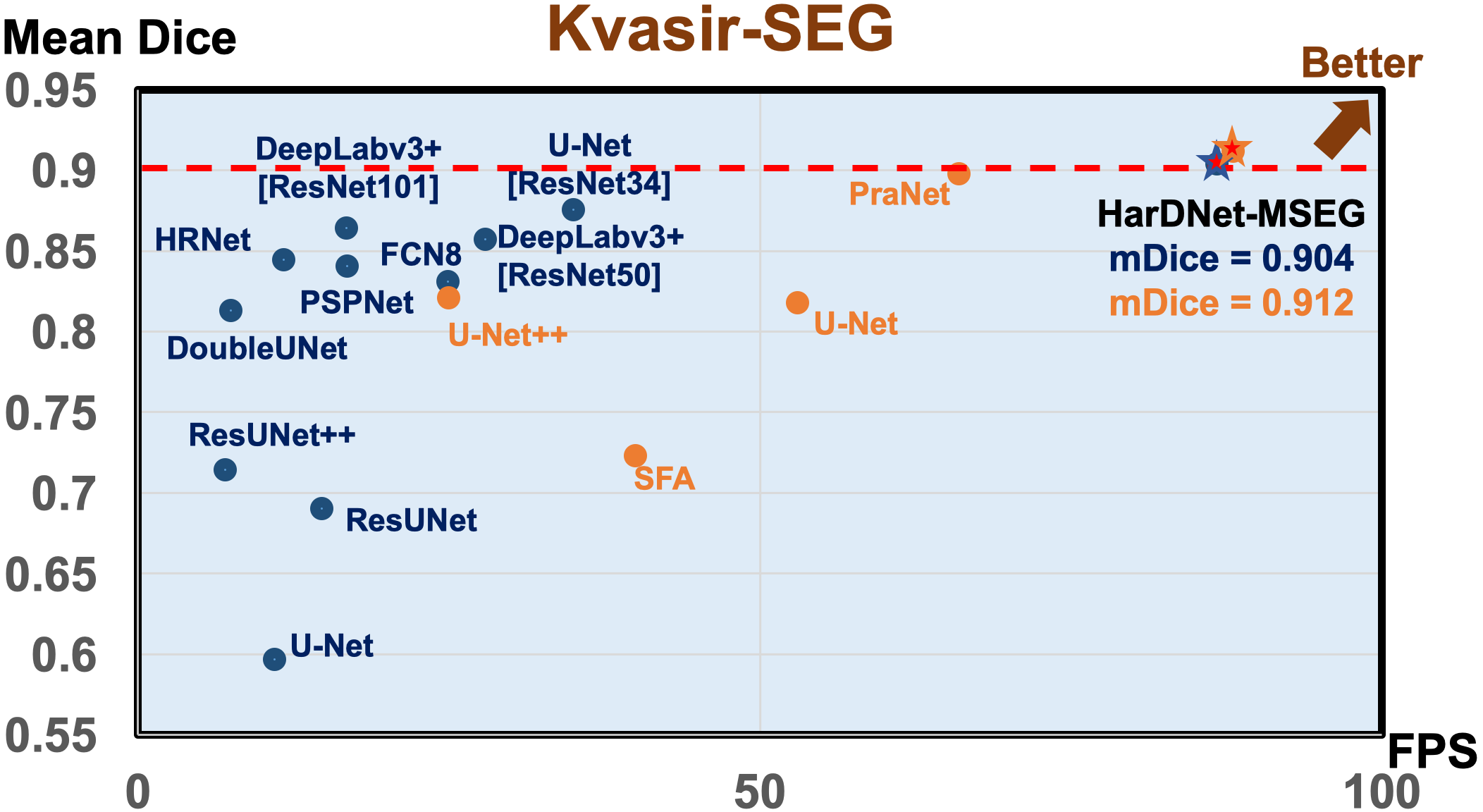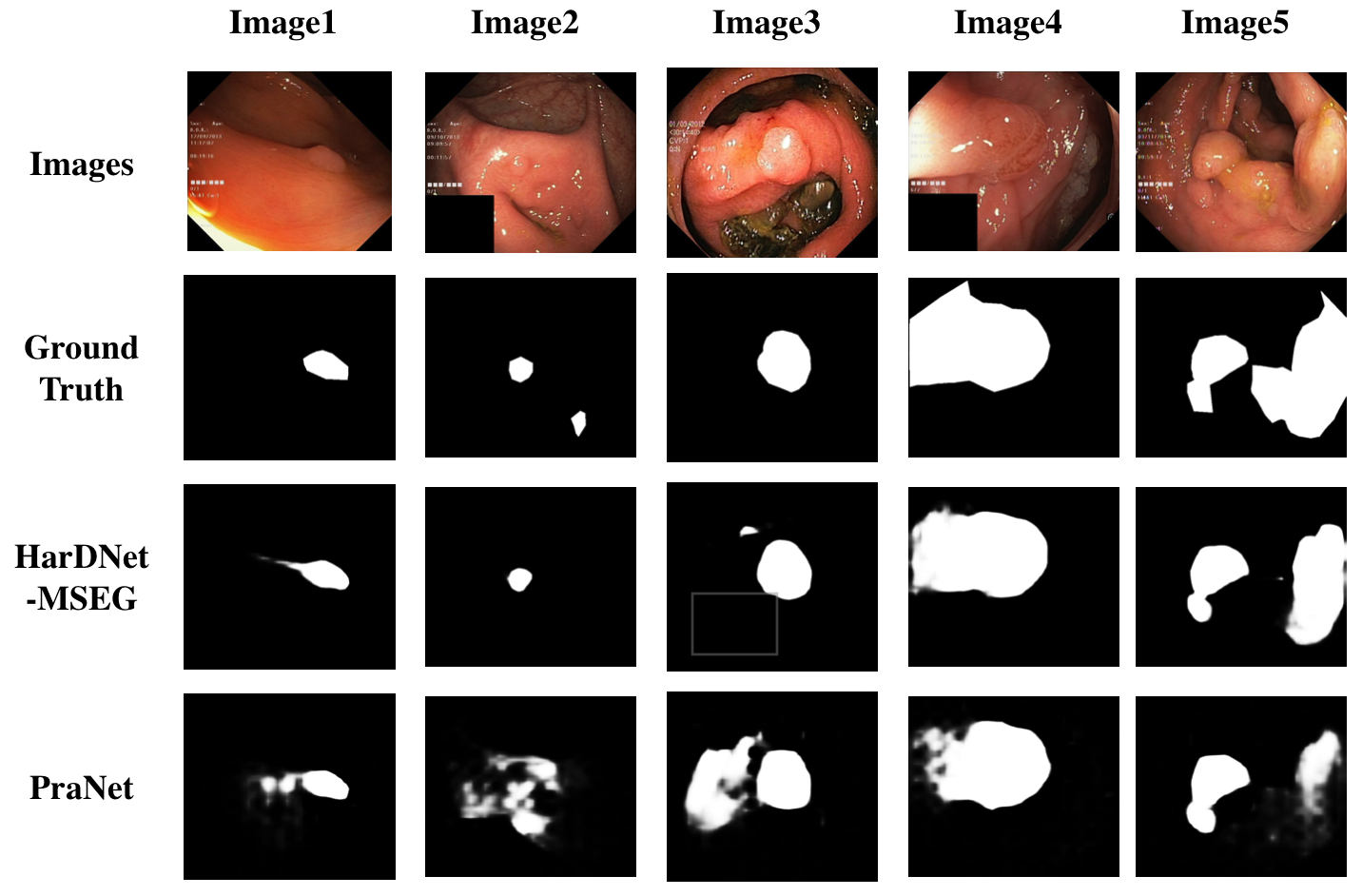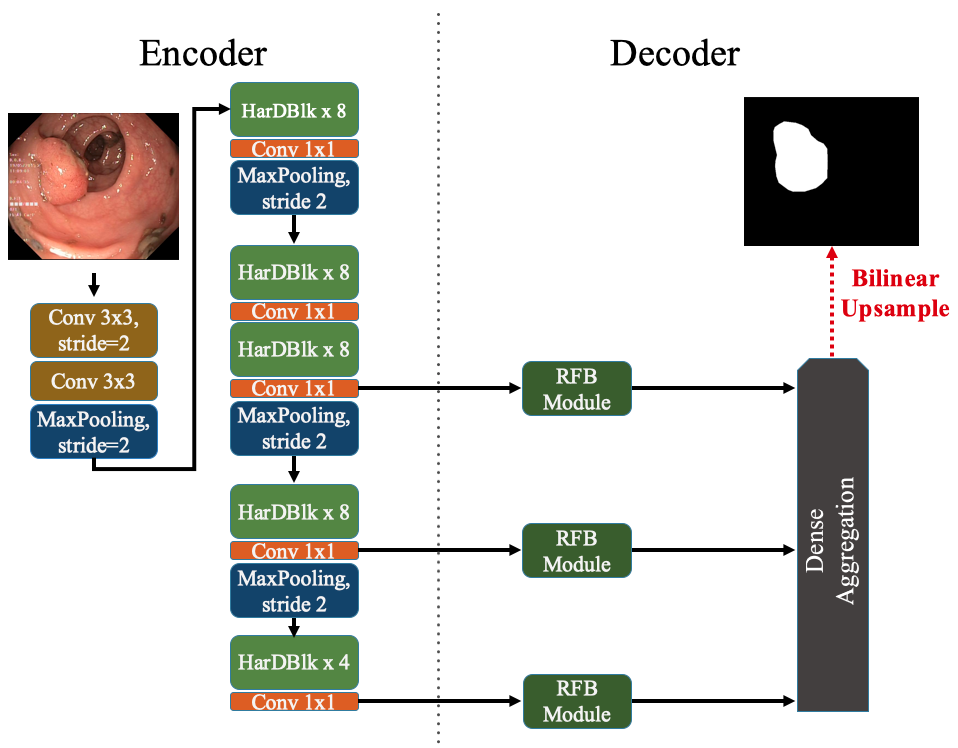HarDNet-MSEG: A Simple Encoder-Decoder Polyp Segmentation Neural Network that Achieves over 0.9 Mean Dice and 86 FPS
Arxiv Paper : HarDNet-MSEG: A Simple Encoder-Decoder Polyp Segmentation Neural Network that Achieves over 0.9 Mean Dice and 86 FPS
ICCV 2019 Paper : HarDNet: A Low Memory Traffic Network
For Image Classification : HarDNet A Low Memory Traffic Network
For Object Detection : CenterNet-HarDNet 44.3 mAP / 45 fps on COCO Dataset
For Semantic Segmentation : FC-HarDNet 76.0 mIoU / 53 fps on Cityscapes Dataset
(Training/Testing split = 880/120 according to Real-Time Polyp Detection, Localisation and Segmentation in Colonoscopy Using Deep Learning) (FPS measures on 2080Ti)
| Models | mIoU | mDice | F2-score | Precision | Recall | Overall Acc. | FPS |
|---|---|---|---|---|---|---|---|
| U-Net | 0.471 | 0.597 | 0.598 | 0.672 | 0.617 | 0.894 | 11 |
| ResUNet | 0.572 | 0.690 | 0.699 | 0.745 | 0.725 | 0.917 | 15 |
| DoubleUNet | 0.733 | 0.813 | 0.820 | 0.861 | 0.840 | 0.949 | 7.5 |
| DeepLabv3+[ResNet50] | 0.776 | 0.857 | 0.855 | 0.891 | 0.8616 | 0.961 | 28 |
| U-Net[ResNet34] | 0.810 | 0.876 | 0.862 | 0.944 | 0.860 | 0.968 | 35 |
| HarDNet-MSEG | 0.848 | 0.904 | 0.915 | 0.907 | 0.923 | 0.969 | 86.7 |
(Training/Testing split = 1450 from 5 datasets /100 from Kvasir-SEG according to PraNet: Parallel Reverse Attention Network for Polyp Segmentation) (FPS measures on 2080Ti)
| Models | mDice | mIoU | wfm | Sm | MAE | maxEm | FPS |
|---|---|---|---|---|---|---|---|
| U-Net | 0.818 | 0.746 | 0.794 | 0.858 | 0.055 | 0.893 | 11 |
| U-Net++ | 0.821 | 0.743 | 0.808 | 0.862 | 0.048 | 0.910 | 25 |
| SFA | 0.723 | 0.611 | 0.67 | 0.782 | 0.075 | 0.849 | 40 |
| PraNet | 0.898 | 0.840 | 0.885 | 0.915 | 0.030 | 0.948 | 66 |
| HarDNet-MSEG | 0.912 | 0.857 | 0.903 | 0.923 | 0.025 | 0.958 | 88 |
-
A Simple Encoder-Decoder architecture
-
Encoder Part : Using HarDNet68 as backbone
+ k = growth rate (as in DenseNet)
+ m = channel weighting factor (1.6~1.7)
+ Conv3x3 for all layers (no bottleneck layer)
+ No global dense connection (input of a HarDBlk is NOT reused as a part of output)
- Decoder Part : Adopted from Cascaded Partial Decoder
+ Using RFB Block for increasing the receptive field and strengthening the features.
+ Dense aggregation for fusing the features.
-
Environment setting (Prerequisites):
-
conda create -n *your_env_name* python=3.6. -
Then install PyTorch 1.1.
-
-
Downloading necessary data:
For Kvasir-SEG Dataset reference from Real-Time Polyp Detection, Localisation and Segmentation in Colonoscopy Using Deep Learning (Only training using Kvasir-SEG, 880 images for training 120 images for testing)
-
downloading testing dataset and move it into your test_path which can be found in this download link (Google Drive).
-
downloading training dataset and move it into your train_path which can be found in this download link (Google Drive).
For each Dataset training including Kvasir-SEG, CVC-ColonDB, EndoScene, ETIS-Larib Polyp DB and CVC-Clinic DB from PraNet: Parallel Reverse Attention Network for Polyp Segmentation
-
downloading testing dataset and move it into your test_path which can be found in this download link (Google Drive).
-
downloading training dataset and move it into your train_path which can be found in this download link (Google Drive).
-
-
Training :
-
First download pretrain_weight : hardnet68.pth for HarDNet68 in https://github.com/PingoLH/Pytorch-HarDNet
-
Change the weight path in lib/hardnet_68.py line 203 for loading the pretrain_weight
-
Change the --train_path & --test_path in Train.py
-
Final step is to run the Train.py
-
-
Testing & inference result :
-
Change the data_path in Test.py (line 16)
-
Here is the weight we trained for Kvasir-SEG using on the report https://drive.google.com/file/d/1nj-zv64RiWwYjCmWg4NME7HNf_nBncUu/view?usp=sharing
Download it, and run "python Test.py --pth_path "path of the weight"
And you can get the inference results in results/
-
- Change the image_root, gt_root in line 49, 50 in eval_Kvasir.py
- Run the eval_Kvasir.py to get a similar result (about +0.002) to our report for Kvasir Dataset.
Another one is written in MATLAB code (link). You can see how to run it in https://github.com/DengPingFan/PraNet#32-evaluating-your-trained-model- And our report is using this code to evaluate.
-
A large part of the code is borrowed from
PraNet (https://github.com/DengPingFan/PraNet) (https://arxiv.org/abs/2006.11392)
Cascaded Partial Decoder (https://github.com/wuzhe71/CPD) (https://arxiv.org/abs/1904.08739)
Thanks for their wonderful works. -
This research is supported in part by a grant from the Ministry of Science and Technology (MOST) of Taiwan.
We thank National Center for High-performance Computing (NCHC) for providing computational and storage resources.
We would also like to thank Mr.Ping Chao for many fruitful discussions.
If you find this project useful for your research, please use the following BibTeX entry.
@misc{huang2021hardnetmseg,
title={HarDNet-MSEG: A Simple Encoder-Decoder Polyp Segmentation Neural Network that Achieves over 0.9 Mean Dice and 86 FPS},
author={Chien-Hsiang Huang and Hung-Yu Wu and Youn-Long Lin},
year={2021},
eprint={2101.07172},
archivePrefix={arXiv},
primaryClass={cs.CV}
}
@inproceedings{chao2019hardnet,
title={Hardnet: A low memory traffic network},
author={Chao, Ping and Kao, Chao-Yang and Ruan, Yu-Shan and Huang, Chien-Hsiang and Lin, Youn-Long},
booktitle={Proceedings of the IEEE International Conference on Computer Vision},
pages={3552--3561},
year={2019}
}



